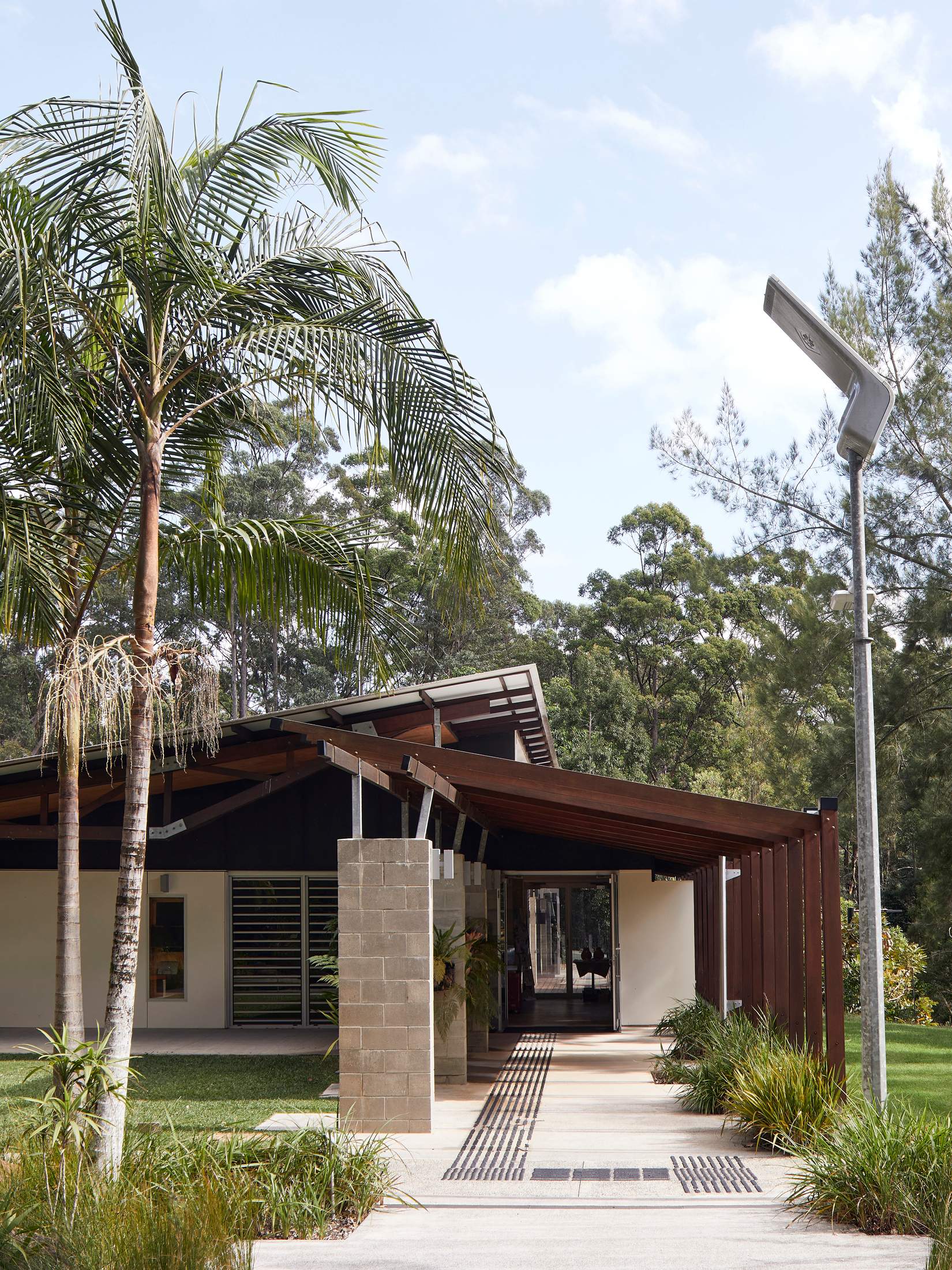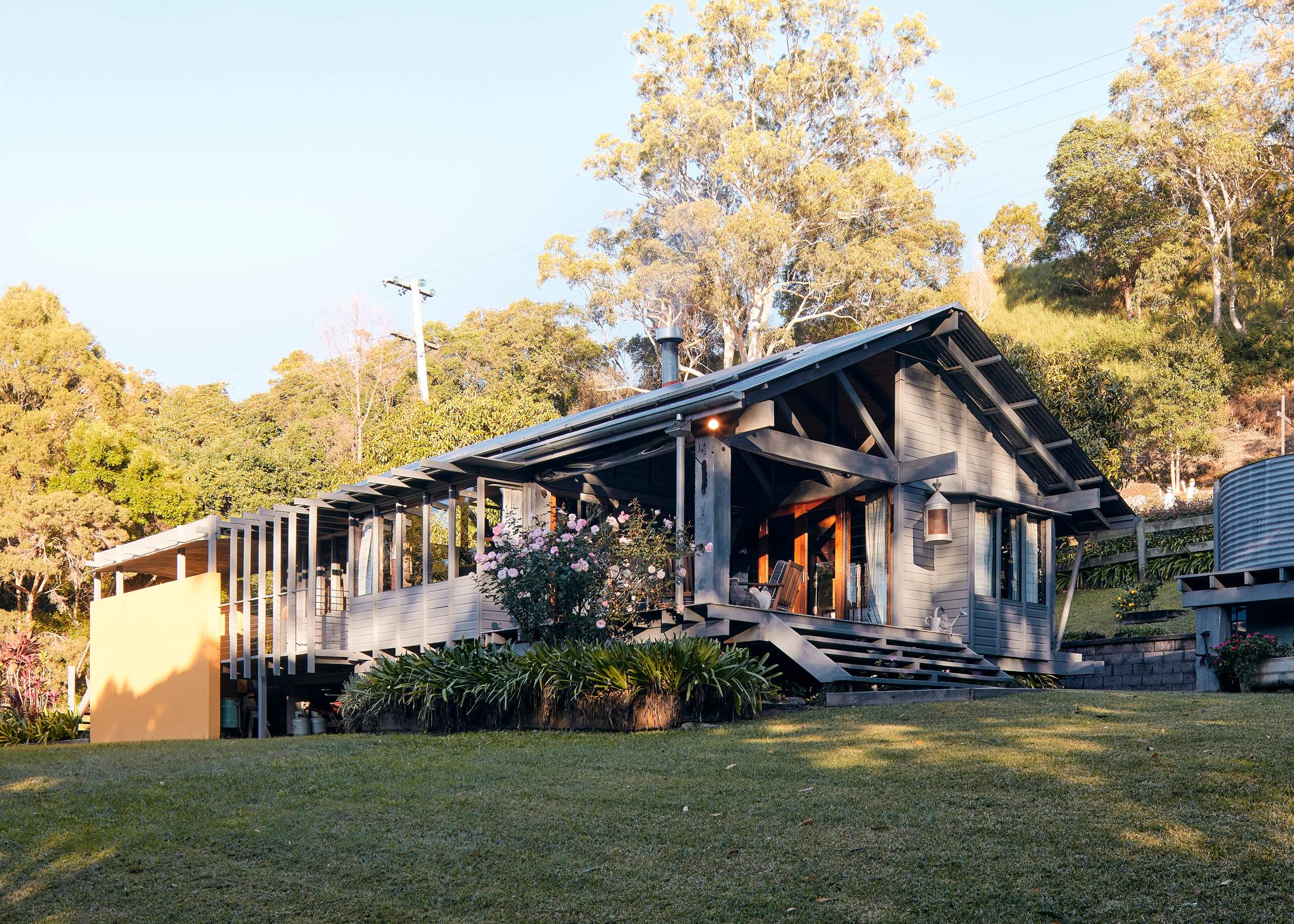Architecture / Sunshine Coast
Sunny disposition
This strip of Australian coastline has developed a gentle architectural style that takes the heat in its stride. Indeed, if you need an air-con system, your design is judged a failure.
It’s not for nothing that the regional cluster of seaside neighbourhoods and hinterland hideaways an hour’s drive north of Brisbane is named the Sunshine Coast (or “Sunny Coast”, as any Aussie will tell you). Here, soft-coloured timber homes with simple tin roofs sit metres away from sandy beaches. On nearby streets, shaded by silvery gum trees, cafés and bars swell with view-chasing diners. Seafood lunches are walked off along sprawling timber boardwalks that the local government goes to great lengths to maintain. After all, these pieces of infrastructure get the most foot traffic in town. The beat of life on the Sunshine Coast strikes a balance between purposeful and laidback – and so does the architecture.

Retractable doors and louvred windows at Spoonbill Beach House by Bark Design Architects

Design in this place of perpetual holiday has long embraced the diverse landscape and subtropical climate that gives the region its obvious liveability. This relaxed and climate-responsive approach favours lighter materials and more modest floorplans. It also seeks to blur the division between indoor and outdoor living.
To the north, Spoonbill Beach House by Bark Design Architects is flanked by sand dunes and a national park. Its design typifies the Sunshine Coast style. Retractable glass doors and louvred windows allow sunlight and sea breezes in. An open-plan living area spills onto the deck, which overlooks a shaded garden. “In cities you have to make a very conscious effort to allow greenery and nature into your design but here you’re already in the landscape,” says Lindy Atkin, who founded Bark with her partner Stephen Guthrie in 1997. Today the pair’s work and lifestyle are based around the gentle pace of life and bountiful nature of the Sunshine Coast. “In 20 minutes I can switch from being on a video call with 30 people to walking in a national park,” says Guthrie. “The innate human need to be able to connect to nature is really accessible here.”

Open to the elements

Maroochy Arts & Ecology Centre by Guymer Bailey

Surfing clubs act as social hubs

Inviting public spaces at the Bark-designed Beerwah Tower Green
Neither Atkin nor Guthrie grew up here but they were both drawn to the Sunshine Coast for work in the 1990s by architectural firms who were busy redefining Australia’s coastal design. Queensland architects Gabriel Poole and John Mainwaring were two of the driving forces behind the movement. Decades ago, well before climate change became a topic of mainstream conversation, Poole and Mainwaring were talking about the importance of sustainability and longevity in new architecture. They helped originate a gold standard of work on the Sunshine Coast that inspired the next generation, including Bark’s founders.
Another Sunshine Coast architect pairing is Kerry Clare and her husband Lindsay, who met while training under Poole in the early 1970s and spent the next 45 years shaping the coast’s vernacular. They’ve garnered widespread acclaim for their climate-driven design aesthetic, which is now typical of the region. One of the couple’s most famous projects, the Gallery of Modern Art in Brisbane (see Issue 75), applied pioneering Sunshine Coast design ideas – such as a slender cantilevering roof, which creates a shaded “outdoor room” on the grass next to the museum – with great success. For the most part, however, the pair are kept busy by humbler residential projects. True to Poole’s training, the Clares work closely with builders and craftsmen to understand what’s possible and which boundaries can be pushed.

Family enjoying a boardwalk stroll

Timber façades providing shade and privacy
Patty and Chris Beecham are the owners of the Clare-designed Bald Knob house nestled in the hinterland area of Maleny. Since the early 1990s the Beechams have been bringing family and friends to their mountain home, which has a protected veranda, cosy fireplace and an indoor shower within a water tank. “Everybody wants a little patch of paradise and our house in Bald Knob is where our souls can rest,” says Patty, a writer-turned-tour operator on the coast and hinterland. As the topography of the Sunshine Coast varies so greatly, the Clares say it is imperative to look at the particulars of every site and not to divorce design from the striking landscape or the subtropical climate. “There’s no point in having air conditioning; if you need it, you have designed the home incorrectly,” says Kerry. “Sitting on a veranda with a breeze blowing through shutters worked 100 years ago so we have kept that in our modern designs.”
Noosa style
In the north of the Sunshine Coast region is handsome beachside town Noosa, which has a whole architectural movement named after its typology of breezy homes. The Noosa style, forged by architect Maurice Hurst, typifies the boundaryless residential design that blurs indoors and outdoors. It is marked by hardy but humble weather-resistant materials, such as timber and tin, and has gone on to inform coastal residential architecture along Australia’s sun-kissed east coast.
Architecture that ignores the climate often produces poor-performing buildings that require expensive cooling or heating systems. This proves to be costly in the long run and detracts from the appeal of living and working in a landscape that others travel great distances to visit. “A lot of people confuse design with aesthetics and, while it’s a key part, design is really about common sense and how you use and move through a space,” says Lindsay. It’s arguably this common-sense approach that has given the Sunshine Coast such a revered reputation; it holds a higher number of prestigious national Robin Boyd awards for residential architecture as Melbourne, Australia’s unofficial design capital.
More and more Australians are making the switch to a permanent address on the Sunshine Coast. Helping to attract this influx of people is a savvy local government that’s harnessing the power of good design. Two years ago the Sunshine Coast Council created a new branch of government that placed all of the urban design employees together. The 50-person-strong design and place-making branch now sees engineers, architects, urban and civil designers and surveyors working in unison to develop a strategy that protects and builds upon the Sunshine Coast’s climate-friendly design standards.

Bald Knob house
One of the team’s first orders of business was to inspire different thinking among the development industry and the community. To do this, they published a smartly produced coffee-table book. “We couldn’t create change without education,” says Sarah Chalkley, the council’s design and place-making manager. “One of the best ways to do this was with a book that people would be inspired by.” The tome, published in January, drives home the point that good design is not generic but, instead, is sensitive to place. “Design has to work towards saving and enhancing what it is that we love and appreciate about the Sunshine Coast,” says Chalkley, a landscape architect by trade, who consulted with the community in order to develop 10 key design principles that now act as a manifesto.
For residents and business owners, the most loved elements of life on the coast are the climate, natural landscape and community connection. And the local council is making a sincere effort to fold these elements into its urban design and new infrastructure.
MONOCLE wraps up its day with a tour of the area’s most popular public spots. This involves a dip in the newly renovated Kings Beach saltwater pool that overlooks the Pacific Ocean. After examining its handsome aluminium-roofed relaxation areas and luscious landscaping, we chat to Phil Jackson, director of Guymer Bailey, the firm behind the refurb. “There’s a lot you can achieve if you design with a sense of place,” he says. Over the past 20 years Jackson has worked on projects that are sensitive to the natural surroundings and retain that all-important flow between inside and out. “The climate is a real asset for the Sunny Coast and it varies a lot, from the beach to the mountains,” he says. “But the indoor-outdoor aspect is what helps to create a real sense of community here. It suits our outdoor lifestyle.”


